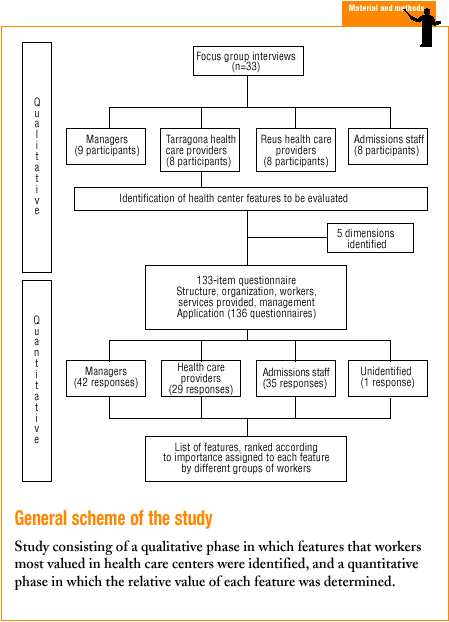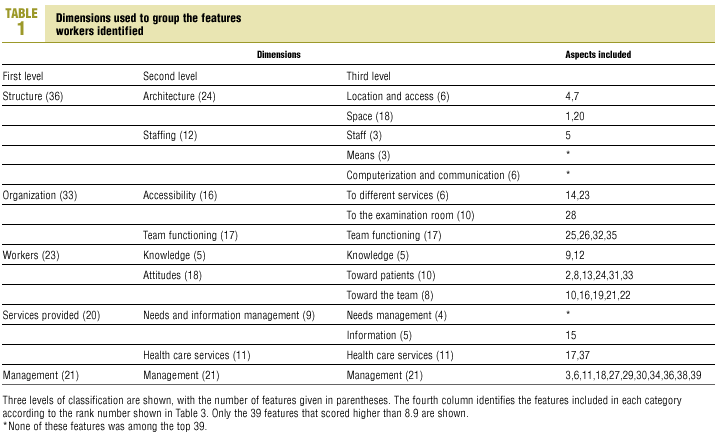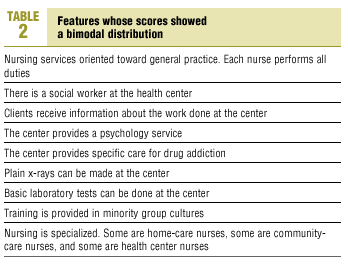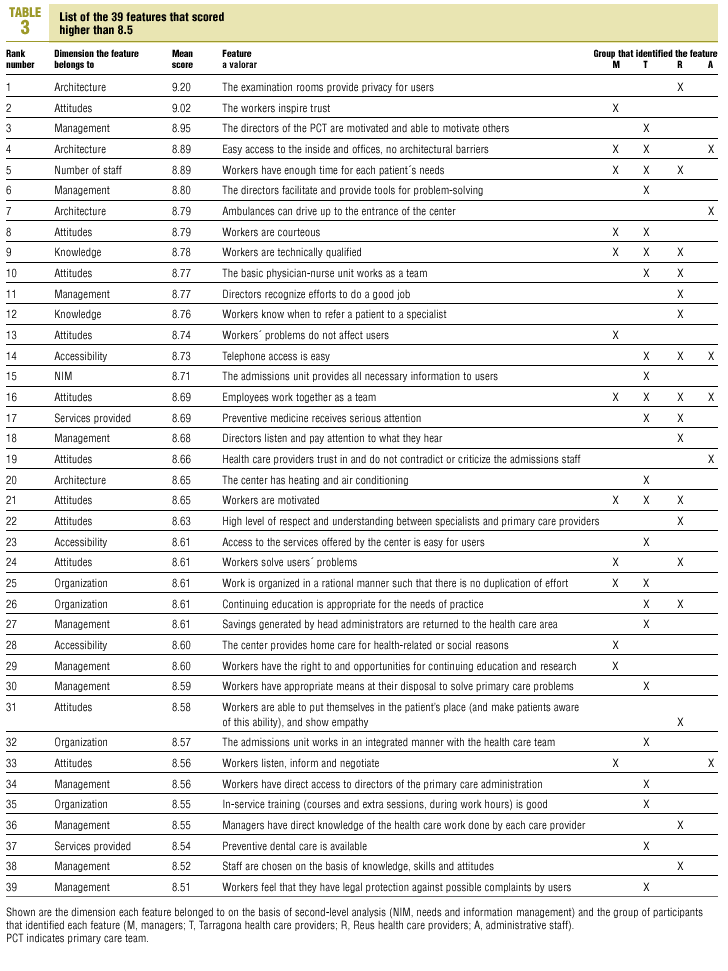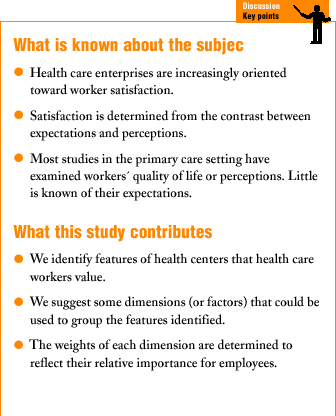Introduction
Health care enterprises that have adopted a business paradigm for total quality management are characterized by their clear concern for the client, and by the particular emphasis they place on human resources. If client satisfaction is the goal which will lead to survival of the enterprise, satisfaction of the workers, i.e., «persons who provide services to other persons»1 is fundamental to achieve this aim. In fact, the European model of managerial excellence2,3 considers worker satisfaction to be one of the 9 fundamental criteria for evaluating how the concern is run.
Health care workers´ satisfaction has been studied in much less detail than patients´ satisfaction.4-7 Carrasco, in a review published in 2000,8 found 15 263 articles on client satisfaction, but only 181 on health care employee satisfaction in a search of Medline items published between 1966 and 2000.
The literature on health care workers usually deals with professional quality of life, which can be considered an indicator of satisfaction as it reveals how health workers experience their relationship with their work.9,10
With regard to workers' expectations, some interesting studies have looked at clients and service providers in parallel11-13 to compare different interests. In this area the extensive study directed by Artells14 on the profile, attitudes, values and expectations of primary care workers is a fundamental source of information.
As is well known, a necessary part of any attempt to determine client satisfaction with a service is identification by the client of those areas, aspects or features are of greatest interest. If this right to define the areas of interest is handed over to experts, the results are incomplete, to say the least.15 It is therefore clear that determining expectations involves asking workers what features they value most.
This reasoning led us to undertake a study designed to identify the features that health care workers´ value as positive characteristics of a health center (i.e., their expectations) and their possible classification in different dimensions. Once the relevant features were identified, their relative importance was determined.
Material and methods
The study was carried out in two phases. The first used qualitative methods, and the second used quantitative methods.
Qualitative phase
In this phase, four focus groups were formed in 1999 and 2000 for content analysis. The four groups were as follows:
Managers in Reus and Tarragona (Northeastern Spain), understood to be directors of local primary care teams, nursing adjuncts, medical directors, nursing directors, health technicians, training directors, and user service directors. To avoid skewing the participants´ opinions, regional primary care directors were not included in this phase.
Physicians and nurses (health care providers) belonging to the Reus Primary Care Administration.
Physicians and nurses belonging to the Tarragona Primary Care Administration. A group of participants from each administration was included in order to study as many opinions as possible from employees who worked in different settings.
Client service staff members who worked in direct contact with clients at the health centers.
Each of the four groups consisted of 12 persons. The script for the interview began with the question «What features do you think an ideal but possible health center should have? What do you think it should be like?» and continued with questions about the organization and internal relations, structure, services provided and relations with users.
Participants were selected so that all possible points of view were represented, and recruitment was aided by persons familiar with the organization of the health service and with the employees who worked there.
The selection criteria were designed to obtain balanced numbers of participants in Reus and Tarragona, of men and women, physicians and nurses, rural and urban workers, senior and junior employees, workers younger and older than 40 years, care providers and non-medical/non-nursing staff, and critics of the system and «conformists». We also sought a balanced number of physicians who had and had not completed specialist training in family and community medicine.
Meetings were held in private dining rooms at restaurants to reduce noise and distractions. All discussions were recorded with two cassette recorders. An observer was present to note instances of nonverbal communication. The recordings were transcribed by a professional transcriber who added the observer´s notes to the transcripts.
Content analysis of the transcripts consisted of identification of units of interest in the text; in this case such units consisted of the features that were mentioned during the interviews. Each interview was analyzed independently by two researchers, who then agreed on a consensus analysis. The units of interest were then grouped into factors or dimensions that referred to the same topic.
The result of this phase was a list of features that different groups of participants considered important for primary care health centers. The features were grouped into dimensions.
Quantitative phase
This phase took place during 2000. The features identified in the qualitative phase were used to prepare a questionnaire that asked participants to evaluate on a scale from 1 (not important at all) to 10 (very important) the importance of each item. The questionnaire was sent to all managers at the Reus and Tarragona administrations, and to one health care provider and one admissions staff member at each local basic health care center. In all 136 questionnaires were distributed, with a covering letter and self-addressed envelope, to 52 managers (including those at the main administrative offices), 42 health care providers and 42 client service staff members. All participants received a telephone reminder to complete and return the questionnaire.
The results of the survey were used to prepare a list of items ranked by mean score for all participants, by type of employee, by function (manager, care provider or client service staff) and by sex.
The initial results were used to identify items whose responses showed a bimodal distribution; these items made up a second questionnaire which was also sent out to participants.
Spearman´s rho was calculated to compare the results obtained with the two lists of questionnaire items. Exploratory principal components analysis was done for the «general» (first) list to provide statistical support for the dimensions defined in the content analysis.
Results
Nine persons participated in the managers´ focus group, 8 participated in the Reus health care providers´ group, 8 in the Tarragona health care providers´ group, and 8 in the client service staff group. All participants satisfied the inclusion criteria.
The managers´ group identified 50 features for evaluation, the Reus health care providers´ group identified 54, the Tarragona health care providers´ group 53, and the client service staff group 39. After duplicate features were eliminated across groups, a total of 133 features for evaluation were identified.
Content analysis grouped these features into 5 dimensions or factors: structure, organization, workers, services provided, and management. These five dimensions were divided into 9 and finally 15 areas (Table 1) that identified the main features included in each level.
A total of 107 completed questionnaires were obtained (78.6% response rate): 42 from managers, 29 from health care providers, and 35 from admissions staff members; the employee category was unknown in 1 questionnaire. Responses were obtained from 36 physicians, 29 nurses and 30 administrators; in 12 cases the type of employee was not known.
The second round of analysis identified 9 items that showed a bimodal distribution (Table 2). A total of 110 statistically useful responses were obtained (80.8% response rate). The results did not differ significantly from those of the first round with regard to the mean score for each item, so for the final analysis we included the results from the first round.
These responses were used to prepare a ranked list of features of health centers that different participants valued. A general list (Table 3) was prepared first, then features were grouped according to type of employee, sex and age. Spearman´s rho revealed no differences between these lists.
Exploratory factor analysis was done for four factors, but because fewer than 1 case was found for each variable, this analysis was not pursued further.
Discussion
The method we used appears to be the most suitable for the aims of the present study. The design, built on an initial exploratory phase with qualitative methods and an evaluation phase with quantitative methods, is becoming more widespread7,16 because of its usefulness in opinion studies.
It can be reasonably assumed that the qualitative phase yielded all information of interest on the topic, as participants were selected in a way that ensured that different points of view toward the organization of primary care services were represented, and recruitment was stopped only when information saturation became evident. However, the quantitative study, although based on a number of cases large enough for the purposes of obtaining a general list of features, did not provide enough power for subgroup analysis. The high response rate by managers might also have skewed the final results. On the other hand, the participation of physicians, nurses and administrative staff was well balanced.
Content analysis was aimed initially at developing a first level classification based on 5 dimensions -- a conceptually straightforward approach that reflects reality (structure, organization, workers, services provided, and management, as the data were from an internal client) and which had been used previously in a similar study of external clients.7 Further second -- and third -- level analyses provided a more finely grained view of how the main dimensions were organized. We decided to include the feature «Workers have enough time to treat patients according to their individual needs» (no. 5) within the structure dimension under «number and type of staff», as we considered that the response to this problem is more closely related with adequate staffing than with improvements in organization (although the influence of organizational measures in improving time management is undeniable). However, the feature «Social worker available at the center» (no. 85) was included under «health care services» in the services provided dimension, as here the decision involves whether this type of service is available, not in determining the necessary number of staff.
The 10 features that scored highest may represent a synthesis of primary health care employees´ ideal set of expectations: workers who work together as a team (no. 10), who are motivated (no. 3) and whose managers provide the necessary means (no. 6), who have enough knowledge (no. 9) and time to treat patients well (no. 5) in an atmosphere of trust (no. 2), courtesy (no. 8) and privacy (no. 1), at a center that is accessible (nos. 4 and 7). An analysis of the 39 items that scored higher than 8.5 shows that of the five dimensions considered here, items included in the workers´ attitudes dimension were the most frequent. Of the 18 items related with attitudes, 11 of them (61%) scored higher than 8.5. Of the 21 items from the management dimension, 11 (52%) scored higher than 8.5. The third most highly valued dimension was workers´ knowledge, with 2 of the 5 items (40%) scoring above 8.5.
Starfield and colleagues, in a study of physicians in the Washington, D.C. area, investigated how workers evaluated the characteristics that define primary care.11 They found that among physicians who were paid according to the number of patients on their list, the most highly valued feature was services provided, whereas their colleagues who were paid according to the number of consultations valued integration of care services most highly. Of a total of 9 features, those dealing with relational aspects were ranked fourth by the former group and third by the latter.
Mira and colleagues13 asked workers what they thought clients valued most highly from a list of 82 items defined by clients and workers. The most highly valued feature was «The physician effectively resolves the patient´s health problems», an item ranked 24th out of 39 in the present study. The second most highly valued feature was «The patient is treated courteously at the doctor´s office», which in the present study was ranked 8th. The next three highest ranked features reported by Mira et al were not among the most important items identified participants in the present study.
Some of the responses in the attitudes dimension merit further comment. There appears to be a strong desire for team work, despite the difficulties this can involve.17 The items «The basic physician-nurse unit works as a team» and «The whole staff work together as a team» were valued highly, ranking 10th and 16th respectively in the list of the 39 items with the highest scores. Artells14 found that 52.5% of all workers surveyed considered that health services should be provided by multidisciplinary teams coordinated by a physician. On a different issue, participants rated highly the item «Workers listen, inform and negotiate», which was ranked 33rd in the present study. However, it appears that this item is valued only if workers are persuasive negotiators, as «Workers are able to accept patients´ suggestions» was ranked in 81st position, much lower down on the list. In our earlier study of external clients7 we found similarities: patients ranked fifth on a list of 60 items the feature «Workers listen to you and pay attention to you», but relegated to 49th place the item «Workers respect patients´ decisions». Torio and García12 also found that neither patients nor health care workers placed much value on the «professional´s advice but patient´s decision» approach. It seems evident that shared decision-making16 is a subtle process: patients wish to have a voice and to be heard, but seem to leave the final decision up to their family doctor. In any case we should consider that many of these items obtained high scores in general, 80 items scoring higher than 8 (of a possible maximum score of 10), and 111 items scoring more than 7.
Table 2 shows features that led to a division of opinion among primary care workers. General vs specialized nursing was one of the divisions that became apparent among participants at the Tarragona center. Five different types of service were considered necessary by some but nonessential by others: availability at the heath center of social service assistance, psychological care, care for drug addictions, x-rays, and basic laboratory tests. Information provided to clients and interest in minority group cultures revealed the existence in the primary care setting of two differing levels of awareness and sensitivity toward social diversity.
In conclusion, health care workers appear to value mainly those features that are related with attitudes toward patients and toward colleagues on the health care team, and those related with management of the center. The differences between our results and those of other studies (some of which differed in focus in important ways from the present report) suggest that, as previously found in a survey of patients,7 the findings in this type of study should not be extrapolated to other situations or systems with different cultures. Further research in this area should help us identify characteristics that are shared by different organizations, and should also provide knowledge about local situations. However, the value of such studies for management is beyond doubt, and managers should take careful note of the aspirations of the health care providers they work for.
In addition, research will make it possible to identify features that merit further study, such as shared decision-making and different levels of sensitivity among health care workers toward organizational and social issues of relevance.
Correspondence: Fernando Palacio. C/ Mañueta, 2, 2.º D. 31001 Pamplona. Navarra. Spain. E-mail: fpalacio2001@yahoo.es
This study was financed in part by project FIS 99/1154.
The present study is part of a larger project aimed at investigating patients´ expectations. Part of the results were reported at the most recent congresses of the Spanish Society of Family and Community Medicine (semFYC) and the Spanish Society for Quality of Care (SECA).
Manuscript received 28 October 2002.
Manuscript accepted for publication 20 January 2003.







